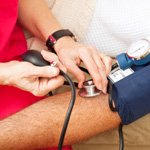Atherosclerosis

What is atherosclerosis?
Atherosclerosis, also known as “hardening of the arteries,” is a condition in which cholesterol-rich plaque builds up along arterial walls. Research suggests that this process probably begins as a result of an injury to the endothelial (inside) lining of an artery wall. The injury may be the result of high cholesterol and triglyceride levels, high blood pressure, chronic system-wide inflammation, smoking and numerous other factors. In response to the injury, white blood cells, along with lipids (fats), begin to accumulate along the inner layer of the artery. The muscle layer of the artery may also grow, forming the basis of a plaque, which many grow large enough to block the artery. If the plaque is disturbed, blood platelets (cells that play a key role in blood clotting) may begin to accumulate at the site and form a clot, which can continue to grow until it completely blocks an artery and cuts off the oxygen supply to a vital organ. Alternatively, a clot can break free from the vessel wall and become lodged somewhere else further downstream. If the clot completely blocks the blood and oxygen supply to a major artery leading to the heart, the result is a heart attack. If an artery to the brain is blocked (as seen, for example, with carotid artery disease), the result is a stroke. Atherosclerosis that affects the arteries in the arms, legs or pelvis is called peripheral artery disease.
What are the symptoms of atherosclerosis?
Atherosclerosis doesn’t cause any symptoms until blood flow through the affected artery slows or becomes blocked. However, when arteries to the heart are affected, symptoms can include chest pain (angina) following a drop in the blood supply to the heart muscle, an increased demand for oxygen by the heart, a combination of both and, sometimes, emotional stress. Angina may feel like pressure or squeezing in the chest, or as pain in the shoulders, arms, neck, jaw, or back. It may even feel like indigestion. To complicate matters further, symptoms are often very different in women than in men. Angina typically worsens with activity and subsides with rest. Other symptoms often present with coronary artery disease include shortness of breath and arrhythmias (abnormal changes in the rate or rhythm of your heartbeat – slower or faster than usual, or irregular).
A narrowing or blockage of an artery leading to the brain can result in a stroke. Symptoms include sudden weakness; paralysis or numbness of the face, arms, or legs, especially on one side of the body; confusion; problems speaking or understanding speech; trouble seeing in one or both eyes; breathing problems; dizziness; trouble walking; loss of balance or coordination and unexplained falls; loss of consciousness; sudden, severe headache.
The symptoms of peripheral artery disease include numbness, tingling, pain, and, sometimes, the development of dangerous infections.
What are the causes of atherosclerosis?
The risk of atherosclerosis increases progressively with age. Recent studies have indicated that you are more likely to develop atherosclerosis if one or both of your parents have had heart disease before age 60. Other risk factors include high cholesterol, smoking, high blood pressure, insulin resistance, diabetes, high triglycerides, being overweight or obese, a sedentary lifestyle and the use of birth control pills or estrogen replacement therapy. Sleep apnea, stress and excessive consumption of alcohol can also raise the risk of atherosclerosis.
In addition, high blood levels of a protein called C-reactive protein indicate inflammation in the body, stemming from injury or infection. Inflammation is now viewed as a major risk factor for heart attack, atherosclerosis and other serious diseases. It isn’t yet known whether reducing CRP levels will lower the risk of atherosclerosis.
How is atherosclerosis diagnosed?
When a physician listens to your neck with a stethoscope, he or she may hear a whooshing or blowing sound (the medical term is “bruit”) that may be present if atherosclerosis has developed in the carotid arteries. High cholesterol levels that show up on blood tests suggest an increased risk for atherosclerosis. The following tests can also help diagnose atherosclerosis:
- Electrocardiogram (EKG): A test to record the heart’s electrical activity. It shows how fast the heart is beating, its rhythm, and can reveal signs of heart damage caused by coronary artery disease and signs of a past or present heart attack.
- Echocardiogram: This test uses sound waves to create a moving picture of the heart. It also yields information about the size and shape of the heart and how well the heart’s chambers and valves are working. Echocardiography can also reveal areas of poor blood flow to the heart, areas of the heart that aren’t contracting normally and previous injury to the heart muscle caused by poor blood flow.
- Computed Tomography (CT Scan): With this test you get computer-generated pictures of the heart, brain or other areas of the body. In the case of the heart, it can show narrowing of large arteries and reveal calcium build-ups in coronary artery walls.
- Stress Test: This is a test to show how long you can continue to walk on a treadmill as the speed increases and how fast your heart rate returns to normal after 30 minutes or less of exercise. A stress test can also reveal abnormal changes in heart rate or blood pressure, shortness of breath or chest pains and abnormal changes in your heart’s rhythm or electrical activity.
- Angiography: With this test, a thin, flexible tube (catheter) is put in a blood vessel of the arm, groin or neck and dye that can be seen on an x-ray is injected through the catheter to the arteries. Then x-rays are taken which show whether plaque or a clot is blocking any arteries, how severe the blockage is and the blood flow through the arteries.
- Ankle/Brachial Index: This test for peripheral artery disease compares blood pressure in the ankle with blood pressure in the arm to reflect how well blood is flowing.
The following imaging tests can show how well blood is moving through the arteries:
- Doppler tests, which use ultrasound or sound waves
- Magnetic resonance arteriography (MRA), a special type of magnetic resonance imagery (MRI) scan
- Specialized computed tomography (CT) scans called CT angiography.
What is the conventional treatment?
In addition to lifestyle changes including a healthy diet to prevent or lower high blood pressure or high cholesterol (or both), giving up smoking, and managing stress, you may get prescription medications to lower cholesterol and blood pressure levels and to prevent blood clots from forming. The following medical procedures may be recommended:
- Angioplasty: This is done to open blocked or narrowed coronary arteries, improve blood flow and relieve angina. It may include installation of a stent (a small mesh tube) to keep the artery open after the procedure.
- Coronary artery bypass grafting: A surgical procedure that involves taking blood vessels from other areas of your body to “bypass” narrowed areas of coronary arteries in order to improve blood flow to the heart, relieve chest pain and, possibly, prevent a heart attack. This same procedure may be used to bypass narrowed or blocked arteries in the leg.
- Carotid endarterectomy: Surgery to remove built-up plaque from the carotid arteries in order to restore blood flow to the brain in an effort to prevent a stroke.
What therapies does Dr. Weil recommend for atherosclerosis?
Dr. Weil recommends making the following lifestyle changes to both lower the risk of atherosclerosis and reduce symptoms once it has manifested. He advises that it’s very important for those with diagnosed atherosclerosis to consult with their physicians before embarking on any lifestyle change:
- Regular exercise to help maintain the health of the vessels leading to the heart. Exercise also can strengthen the heart muscle itself.
- Follow a low-glycemic diet.
- Stop smoking.
- Control your blood pressure.
- Maintain good dental health: Because gum disease can cause or worsen atherosclerosis, it is vital to brush your teeth at least twice a day and floss daily to avoid the buildup of small amounts of food that attract and nourish bacteria. In addition, be sure to have regular dental checkups so that any gum disease can be identified and treated promptly.
In addition, Dr. Weil suggests that anyone with atherosclerosis take these supplements:
- Fish oil. It appears that the omega-3 fatty acids in fish and fish oil supplements can help prevent heart disease. They can lower triglyceride levels, increase HDL (“good”) cholesterol, help minimize inflammation and blood clotting, and keep blood vessels healthy.
- Coenzyme Q10 (CoQ10). This antioxidant helps protect LDL (“bad”) cholesterol from oxidation, maintain healthy blood vessels, lower blood pressure, and can support optimal functioning of the heart muscle.









